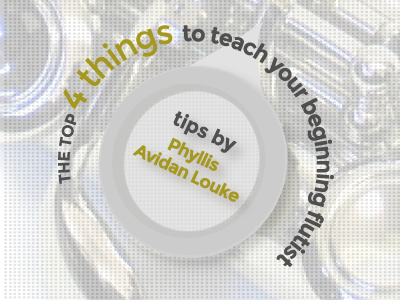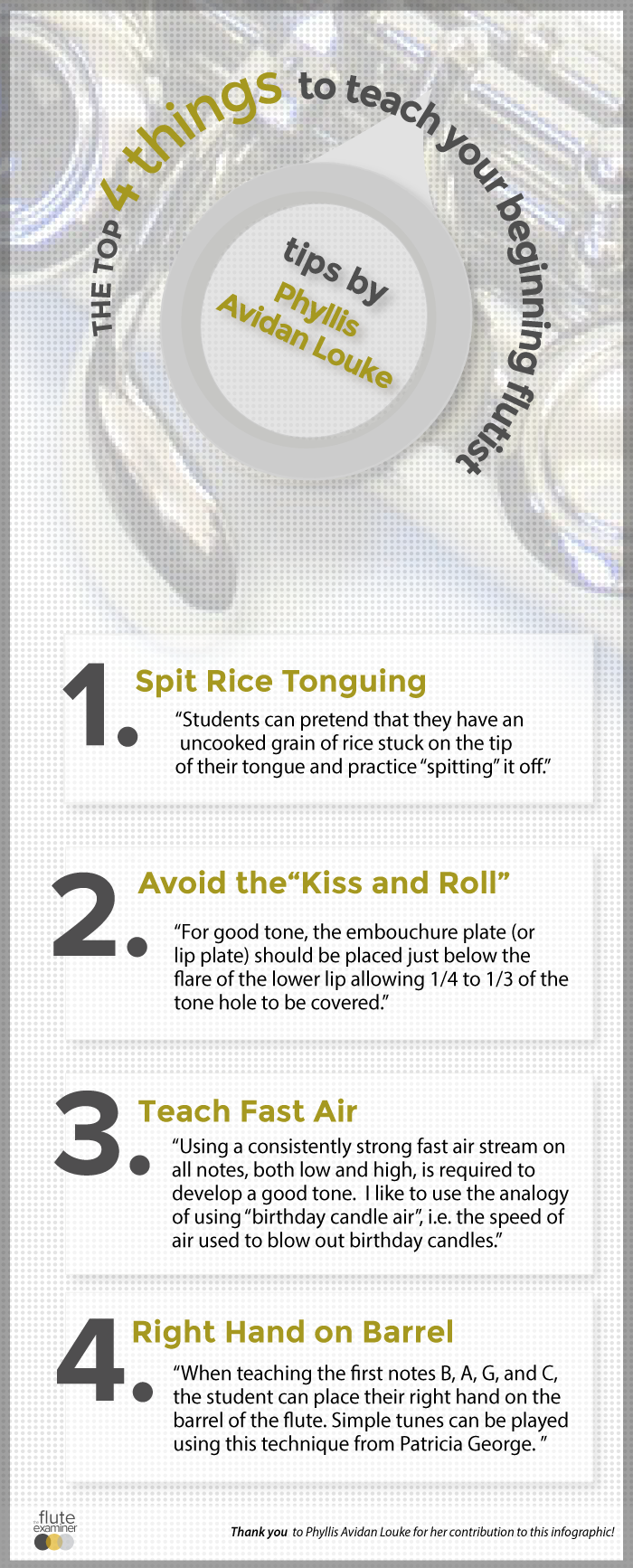I had the pleasure to speak with Phyllis Avidan Louke this month to pick her brain about the art of teaching beginning flutists. I have been reading Phyllis’ articles in Flute Talk, and using her Flute 101 method book for many years. She is an expert in flute pedagogy and most flute-related topics.
Phyllis is an Altus Artist, an award winning composer and arranger, and a wonderful person. For more on Phyllis, visit her website. For more information on her collaboration with Patricia George, including new publications, visit The Fabulous Flute Music Company.
I want to extend gratitude to Phyllis for her time contributing the tips in this article and infographic!
1. Spit Rice Tonguing
Excerpt from Phyllis’s article “Teaching the Basics of Tone Production”
“Students can pretend that they have an uncooked grain of rice stuck on the tip of their tongue and practice “spitting” it off. The goal is to “spit” the rice far away from you (i.e. across the room). When this is done correctly, the tongue will touch the inside wet part of the lips, even appearing slightly through the lips, and will produce a little “pop” as the tongue is pulled back releasing the pressurized air. This should produce a fast stream of air through a small aperture formed between the lips. If the air isn’t fast enough, the rice will just “dribble down to your toes”. For those who have trouble visualizing the tongue placement, real rice can be used (outdoors, of course) to practice the technique, and have some fun, aiming at targets.”
2. Avoid the Infamous “Kiss and Roll” – Know correct placement on the lip plate.
Excerpt from Phyllis’ article “Ten Things that Every Band Director Should Know About Flutes ”
“For good tone, the embouchure plate (or lip plate) should be placed just below the flare of the lower lip allowing 1/4 to 1/3 of the tone hole to be covered. The student should be able to feel the edge of the tone hole under the flare of their lower lip, which will help with placement. This position enables flexibility of the lower lip, which controls the angle of the air stream. Students with full lips having difficulty with sound production, can place the lip plate slightly higher directly on the lower lip. Traditional methods of placement such as “kissing” the tone hole and then rolling tend to place the lip plate too high for many players.”
3. Teach Fast Air
“Using a consistently strong fast air stream on all notes, both low and high, is required to develop a good tone. I like to use the analogy of using “birthday candle air”, i.e. the speed of air used to blow out birthday candles.”
“Many other fast air techniques, such as the blowing hard enough to hold a piece of paper on the wall, tends to cause tension in the neck. An exercise to create awareness of the breathing process is to have the students hook their hands around the lower rib cage so they can feel the lungs expand and contract. This counters the “diaphragmatic” breathing myth, which can leave the student confused.”
4. Right Hand on Barrel
“This technique was actually developed by Patricia George. First, have the student remove the footjoint. Then, have the student grab the flute with the right hand on the barrel. The student can still play simple tunes using the left hand keys.” (see video below for a video demonstrating Right Hand on Barrel)
“For right hand placement I like having a small tactile indicator under the right hand thumb. It serves as a reminder to the student where to place the hand. I used to use a small round Dr. Scholl’s corn pad, but they’ve stopped making them. I’ve started using a little bit of masking tape instead.”
Another great tip (learned from Patricia George) for the right hand, is the ‘coke can test.’ Have your student grab a can to see whether the thumb lines up below the index finger, middle finger, or somewhere in between. This will determine the most ideal placement for the right hand thumb during playing.”
The following video by Jennifer Cluff demonstrates the “right hand on barrel” technique at 5 minute 36 seconds.
What is your favorite tip for beginning flutists? Comment below!



Thanks Phyllis.. Holding the flute to keep it from turning while playing